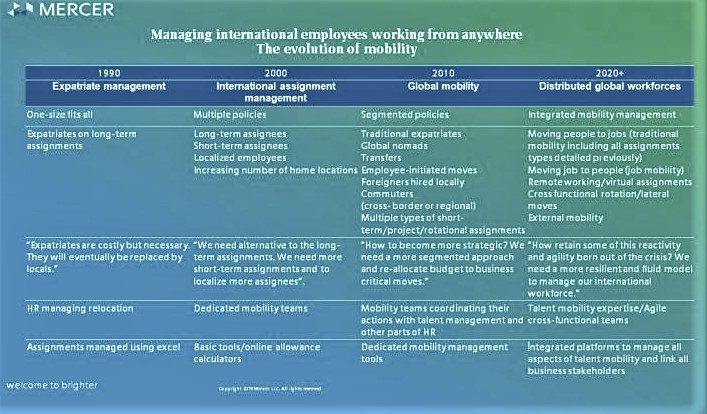Click here to add your own text

Managing international employees
working from anywhere,
part 1:
Redefining mobility
By Olivier Meier, Mercer
For years, global mobility has conjured images of complex relocation processes and expatriates receiving costly pay packages in the minds of managers.
At the same time, many other forms of talent mobility have been happening within organizations: internal career mobility managed by talent management, job mobility lead by global expansion teams, and the use of international freelancers managed by various part of HR and recruitment.
Attempts have been made to bring together the pieces of the puzzle by building bridges between departments and integrating the concept of mobility into a consistent business strategy. Progress has been real, but implementation has resulted in a patchwork of policies and practices in most companies.
The consequences of the COVID-19 crisis are accelerating this evolution. During the crisis, rigid categories of mobile employees and the official purview of the mobility were not always reflecting the realities of the business. New forms of mobility and remote working have emerged. They are prompting a reassessment of what it means to work globally.
Furthermore, cost containment imperatives and the necessity to build up business resilience are accelerating further the pace of change.
These changes require, above all, a change of mindset and operating model: instead of trying to fit assignees into predefined boxes corresponding to the purview of mobility teams, the objective is to manage a diverse international workforce in a fluid and integrated way.
Defining:
objectives of mobility
It’s impossible to define mobility without first clarifying its strategic objectives for the business. There is always a risk for HR to lose sight of the bigger picture as strategic considerations dissolve in the urgency of day-to-day tasks. Too many mobility discussions are focused on tactical issues about relocation and the cost of assignee packages. Relocating individuals is not an objective as such.
The main objectives of mobility for the business are:
- Rightsizing and diversifying the international talent pool: efficient mobility talent management goes hand in hand with decisions about international workforce resizing, reshaping, and reskilling. It is as much about managing an international talent pool as about moving people from country to country.
- Ensuring the right leadership talent pipeline is in place.
- Addressing key skill shortages in critical markets.
- Fostering talent diversity. If international experience is the best way to reach top management, the underrepresentation of women and minorities in the expatriate workforce is blocking the diversity initiative.
- Protecting key talents: the tactical deployment of key talent from stagnant markets to more active markets.
- And more generally enabling continued globalization of functions and business activities.
Evolution:
mobility management
International mobility has been evolving over the years to integrate new business needs and the growing complexity of the global mobile workforce.
| 1990 | 2000 | 2010 | 2020+ |
|---|---|---|---|
| Expatriate management | International assignment management | Global mobility | Distributed global workforces |
| One-size fits all | Multiple policies | Segmented policies | Integrated mobility management |
| Expatriates on long-term assignments | Long-term assignees Short-term assignees Localized employees Increasing number of home locations |
Traditional expatriates Global nomads Transfers Employee-initiated moves Foreigners hired locally Commuters (cross- border or regional) Multiple types of short-term/project/rotational assignments |
Moving people to jobs (traditional mobility including all assignments types detailed previously) Moving job to people (job mobility) Remote working/virtual assignments Cross functional rotation/lateral moves External mobility |
| “Expatriates are costly but necessary. They will eventually be replaced by locals.” | “We need alternative to the long-term assignments. We need more short-term assignments and to localize more assignees”. | “How to become more strategic? We need a more segmented approach and re-allocate budget to business critical moves.” | “How retain some of this reactivity and agility born out of the crisis? We need a more resilient and fluid model to manage our international workforce.” |
| HR managing relocation | Dedicated mobility teams | Mobility teams coordinating their actions with talent management and other parts of HR | Talent mobility expertise/Agile cross-functional teams |
| Assignments managed using excel | Basic tools/online allowance calculators | Dedicated mobility management tools | Integrated platforms to manage all aspects of talent mobility and link all business stakeholders |
The original mobility management thinking was based on a linear experience: moving an employee from location A to location B and bring that person back after a set period of time. Organizations now have to manage distributed international workforces on an on-going basis – in other words, a workforce that is dispersed geographically, could be working from home or from an office, and will have different contractual statuses (home/host-based, permanent/temporary).
Companies will re-open the debate about moving jobs to people rather than moving people to jobs.
As companies gain in agility and upgrade their technology, it could even be about assigning projects and tasks to mobile people rather than moving defined jobs as such.
Companies need to define to what extent they will allow virtual assignments as alternative to international relocation. This concept of virtual assignments itself should be addressed within the broader HR framework of remote working/working from home.
Mobility should also increasingly mean promoting lateral mobility: moving between types of jobs as opposed to being promoted with the same job family (vertical moves).
It is a precondition for talent retention as the number of senior manager positions available in a given company is limited and not all employees can make it to the top. Lateral career moves can be important for repatriated expats.
Companies struggle to guarantee them a job upon repatriation, and facilitating lateral moves instead of trying to implement straightforward promotions following an assignment could be part of the solution.
Lateral moves in the form of talent exchange/temporary rotation are a way to build up talent within the company by exposing high potential employees to the realities of different departments. In times of crisis, it’s a way to retain talent and increase the organization capacity to address resource imbalances between business units.
Mobility can also be about external mobility:
Lending talent to other organizations for development or retention purposes.
Mercer’s 2020 Talent Trends study found out that 59% of respondents are considering offering secondments outside of the company to some of their employees.
Temporary talent sharing is a way tom mitigate the impact of the crisis: a portion of lending employer’s employees works for a host employer for a period of time. The employees return to work at the lending employer with minimal disruption to income and well-being. The host employer is able to efficiently flex staffing to address short-term spike in demand.
Gig workers and freelancers play a significant role in the mobile workforce.
The Crisis may have affected them more than full time employees in the short-term but 77% of executives responding to the Mercer Talent Trends study think that gig workers and freelancers will substantially replace full-time employees in the next five years. Throughout their career many people will move between jobs (sometimes returning to a previous employers) and between the status of employee and free-lancer. Managing effectively this ebb and flow of talent will become a priority for company.
Reinventing:
mobility function
Building business resilience requires better integration of the different teams. HR, risk management, healthcare, compliance, and other relevant topics are managed by different teams spread geographically and between business units. During the crisis, many mobility teams are rising to the challenge and leverage their international expertise to help the business. However, they face issues that have little to do with their day-to-day tasks and often struggle to find the right contacts. Gaps between teams delay reaction time and add to the general confusion. Bridging these gaps will require more than just changes in organization structure. It will necessitate more agility in operating models.
The debate about HR adopting Agile techniques pioneered by IT product development was initially focused on how HR teams to design policies and manage project more effectively. The priority is now shifting to agile teaming.
Mercer’s talent trends study found that “when asked about what is the most important to being more agile only 5% of companies said agile work practices (such as iterative product build and prototype testing) and just 15% said agile organization design. Instead it was agile teaming – fluid teams that join and disband as needed – and agile workers (30%) that companies said would them more agile.”
Agile teaming is the capacity to work efficiently and manage an agile team composed of diverse team members – a diversity in terms of culture but also competencies and functions. It’s a precondition to develop effective cross-functional teams and flash teams (assembling and reassembling teams fast to respond to an urgent business issue.)
Applied to international assignments, agility is about setting shorter, more flexible assignments. It could also be about combining traditional mobility with remote working (e.g. combination of a short-term assignment followed by a virtual assignment from home.)
From relocation management to
international talent brokering
As the organization become more agile, the role of mobility and international team will shift from relocation management to international talent brokering.
International talent brokering mark a return to the strategic objectives of mobility.
It is about matching job, skills and people globally as well as assessing the feasibility of different types of mobility, ensuring compliance, containing costs, and improving employee experience.
Will traditional expatriates disappear?
What’s the future of the mobility industry?
These questions are less relevant than it seems at first glance.
The future is bright for skilled international HR professionals willing to step out of the traditional global mobility silo and embrace the opportunities of managing distributed global workforces.

